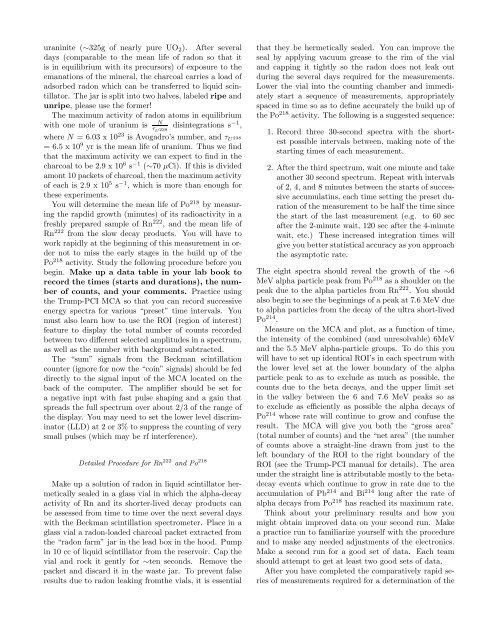The Quantum Mechanics of Alpha Decay
The Quantum Mechanics of Alpha Decay
The Quantum Mechanics of Alpha Decay
You also want an ePaper? Increase the reach of your titles
YUMPU automatically turns print PDFs into web optimized ePapers that Google loves.
uraninite (∼325g <strong>of</strong> nearly pure UO 2 ). After severaldays (comparable to the mean life <strong>of</strong> radon so that itis in equilibrium with its precursors) <strong>of</strong> exposure to theemanations <strong>of</strong> the mineral, the charcoal carries a load <strong>of</strong>adsorbed radon which can be transferred to liquid scintillator.<strong>The</strong> jar is split into two halves, labeled ripe andunripe, please use the former!<strong>The</strong> maximum activity <strong>of</strong> radon atoms in equilibriumNwith one mole <strong>of</strong> uranium isτ disintegrations s−1 ,U 238where N = 6.03 x 10 23 is Avogadro’s number, and τ U 238= 6.5 x 10 9 yr is the mean life <strong>of</strong> uranium. Thus we findthat the maximum activity we can expect to find in thecharcoal to be 2.9 x 10 6 s −1 (∼70 µCi). If this is dividedamont 10 packets <strong>of</strong> charcoal, then the maximum activity<strong>of</strong> each is 2.9 x 10 5 s −1 , which is more than enough forthese experiments.You will determine the mean life <strong>of</strong> Po 218 by measuringthe rapdid growth (minutes) <strong>of</strong> its radioactivity in afreshly prepared sample <strong>of</strong> Rn 222 , and the mean life <strong>of</strong>Rn 222 from the slow decay products. You will have towork rapidly at the beginning <strong>of</strong> this measurement in ordernot to miss the early stages in the build up <strong>of</strong> thePo 218 activity. Study the following procedure before youbegin. Make up a data table in your lab book torecord the times (starts and durations), the number<strong>of</strong> counts, and your comments. Practice usingthe Trump-PCI MCA so that you can record successiveenergy spectra for various “preset” time intervals. Youmust also learn how to use the ROI (region <strong>of</strong> interest)feature to display the total number <strong>of</strong> counts recordedbetween two different selected amplitudes in a spectrum,as well as the number with background subtracted.<strong>The</strong> “sum” signals from the Beckman scintillationcounter (ignore for now the “coin” signals) should be feddirectly to the signal input <strong>of</strong> the MCA located on theback <strong>of</strong> the computer. <strong>The</strong> amplifier should be set fora negative inpt with fast pulse shaping and a gain thatspreads the full spectrum over about 2/3 <strong>of</strong> the range <strong>of</strong>the display. You may need to set the lower level discriminator(LLD) at 2 or 3% to suppress the counting <strong>of</strong> verysmall pulses (which may be rf interference).Detailed Procedure for Rn 222 and Po 218Make up a solution <strong>of</strong> radon in liquid scintillator hermeticallysealed in a glass vial in which the alpha-decayactivity <strong>of</strong> Rn and its shorter-lived decay products canbe assessed from time to time over the next several dayswith the Beckman scintillation spectrometer. Place in aglass vial a radon-loaded charcoal packet extracted fromthe “radon farm” jar in the lead box in the hood. Pumpin 10 cc <strong>of</strong> liquid scintillator from the reservoir. Cap thevial and rock it gently for ∼ten seconds. Remove thepacket and discard it in the waste jar. To prevent falseresults due to radon leaking fromthe vials, it is essentialthat they be hermetically sealed. You can improve theseal by applying vacuum grease to the rim <strong>of</strong> the vialand capping it tightly so the radon does not leak outduring the several days required for the measurements.Lower the vial into the counting chamber and immediatelystart a sequence <strong>of</strong> measurements, appropriatelyspaced in time so as to define accurately the build up <strong>of</strong>the Po 218 activity. <strong>The</strong> following is a suggested sequence:1. Record three 30-second spectra with the shortestpossible intervals between, making note <strong>of</strong> thestarting times <strong>of</strong> each measurement.2. After the third spectrum, wait one minute and takeanother 30 second spectrum. Repeat with intervals<strong>of</strong> 2, 4, and 8 minutes between the starts <strong>of</strong> successiveaccumulatins, each time setting the preset duration<strong>of</strong> the measurement to be half the time sincethe start <strong>of</strong> the last measurement (e.g. to 60 secafter the 2-minute wait, 120 sec after the 4-minutewait, etc.) <strong>The</strong>se increased integration times willgive you better statistical accuracy as you approachthe asymptotic rate.<strong>The</strong> eight spectra should reveal the growth <strong>of</strong> the ∼6MeV alpha particle peak from Po 218 as a shoulder on thepeak due to the alpha particles from Rn 222 . You shouldalso begin to see the beginnings <strong>of</strong> a peak at 7.6 MeV dueto alpha particles from the decay <strong>of</strong> the ultra short-livedPo 214 .Measure on the MCA and plot, as a function <strong>of</strong> time,the intensity <strong>of</strong> the combined (and unresolvable) 6MeVand the 5.5 MeV alpha-particle groups. To do this youwill have to set up identical ROI’s in each spectrum withthe lower level set at the lower boundary <strong>of</strong> the alphaparticle peak to as to exclude as much as possible, thecounts due to the beta decays, and the upper limit setin the valley between the 6 and 7.6 MeV peaks so asto exclude as efficiently as possible the alpha decays <strong>of</strong>Po 214 whose rate will continue to grow and confuse theresult. <strong>The</strong> MCA will give you both the “gross area”(total number <strong>of</strong> counts) and the “net area” (the number<strong>of</strong> counts above a straight-line drawn from just to theleft boundary <strong>of</strong> the ROI to the right boundary <strong>of</strong> theROI (see the Trump-PCI manual for details). <strong>The</strong> areaunder the straight line is attributable mostly to the betadecayevents which continue to grow in rate due to theaccumulation <strong>of</strong> Pb 214 and Bi 214 long after the rate <strong>of</strong>alpha decays from Po 218 has reached its maximum rate.Think about your preliminary results and how youmight obtain improved data on your second run. Makea practice run to familiarize yourself with the procedureand to make any needed adjustments <strong>of</strong> the electronics.Make a second run for a good set <strong>of</strong> data. Each teamshould attempt to get at least two good sets <strong>of</strong> data.After you have completed the comparatively rapid series<strong>of</strong> measurements required for a determination <strong>of</strong> the















